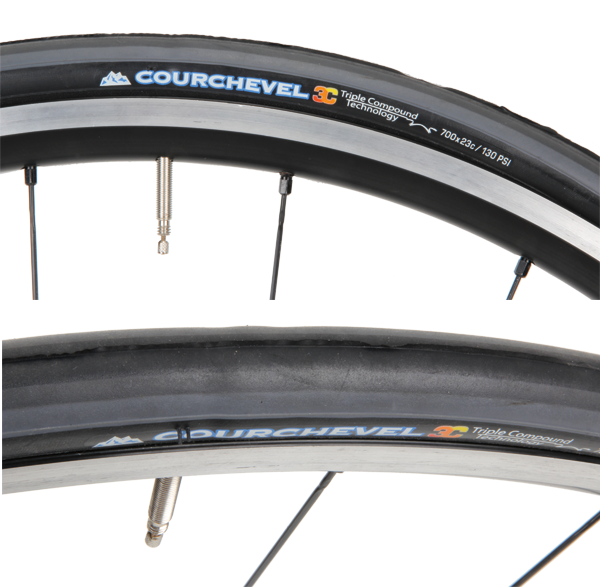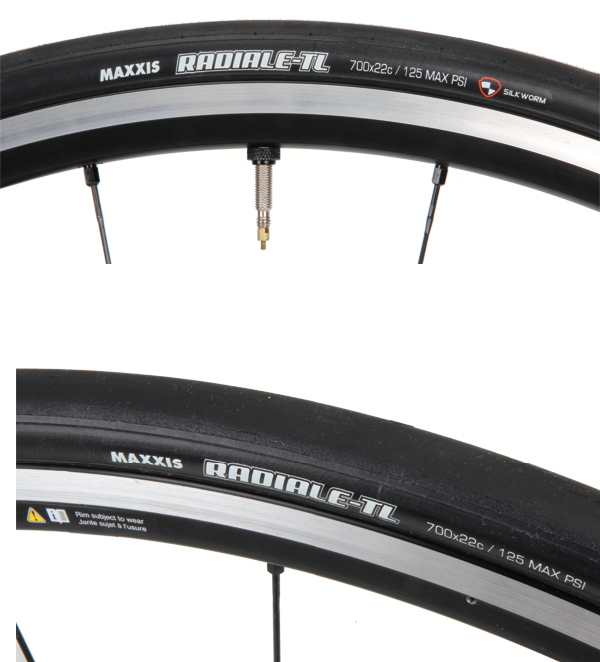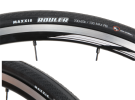When the time comes to replace the tyres on your road bike, the choice on the bike shop wall is massive. Several different brands are likely waiting at your local shop, with multiple models in each range to choose from as well. Should you try getting advice and preferences from various guys at a few of your local bike shops, or will that just add to your confusion? Or should you just pick a likely looking one and ride off?We collected three very different tyres from one manufacturer, MAXXIS, to see what we can find out.
Two MAXXIS Rouleurs was the first set that we mounted up and went riding.
Checking the specs on the Maxxis website, the Rouleur was looking good; Silkworm puncture protection under the dual compound tread, 700 x 23c sizing, 200g weight per tyre and all black which suits every bike out there on the road.
Weighing the Rouleurs produced the first surprise, 228g for one and 227g for the other, 14 percent over the advertised weight! The tyres set up easily and spun true on the first go. Riding at a standard pressure of 120psi, they rolled off down the road very well, as expected.

Rolling resistance is something that was never going to be scientifically measured in a test at this level but a general feeling of the tyres ability to ride in the real world gives a better indication of the tyres value.
The Rouleur’s only other slight hiccup was the transition between the smooth, fast rolling centre tread and the grooved outer, softer section. A slight change in the feeling on the bike, both through the handlebars and the saddle made us realise that we were onto the outer edges of the tyre.
The Silkworm puncture protection worked as claimed, or had no intrusions to repel, as we had no punctures during the test period.
A pair of Courchevel 700 x 23c was the next set to grace the test bike and running MAXXIS 3C triple compound and MAXX SHIELD protection from bead to bead, these tyres seemed to be packed with technology. Despite this they weighed in at 218g each, seven grams under the suggested 225g.

On the road, the Courchevels instantly felt fast and stable. Rolling over rough, potholed tar, they held a smooth line and protected the rider from the rough road. Cornering at speed left us wanting to dive deeper into the apex and let the tyres work harder. Eventually, the front end started to run wide when the softest compound bit into the tar, but the grip levels are high and reliable.
The Courchevels are a great choice as a high end, all round training and racing tyre.
Maxxis Radiale-TL
Tubeless tyres are nothing new in the mountain bike world; they’ve been around for decades in automotive market too. It seems the trend is slowly catching on in road as well. Maxxis has delivered us a Radial Tubeless tyre meaning that the bead is designed to seal against the edge of a tubeless specific rim and the inside layer of the tyre is made of butyl just like your tubes. The cords in the casing run lengthways around the tyre not across it as normal allowing the sidewall to be much more supple and help to increase traction when cornering.

Setting them up was a breeze, with tubeless rims of course. A tyre lever (supplied) was needed to get the tyre over the rim bead but from there, all that was needed was a standard floor pump and the tyres inflated with ease. Without sealant in them, the tyres lost a little more pressure than expected but by adding 20g of sealant to each tyre, riding pressure was held for day after day of the test.
120psi was used on the first ride and the tyres felt fast and sure footed, as you’d expect for a high-end tyre. Then things got interesting when we dropped the pressures back to 100psi. For our 75kg rider, the tyre didn’t feel slow, soft or underinflated compared to the 120psi test. Cornering traction just got better. At 90psi, though the 22c tyres started to feel slow and unresponsive. Usually our rider prefers to ride with tyres inflated to 120psi. Favourite tyre pressures are something that only you as a rider can decide, but for this test, and this rider, using this tyre, 95 to 100psi was the sweet spot bringing significantly improved traction and cornering speed.
With the sealant dealing with small punctures, time on the bike will only be made more enjoyable.
